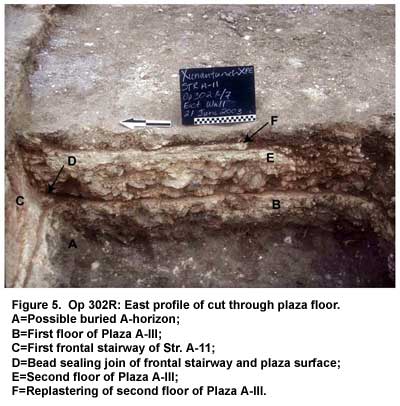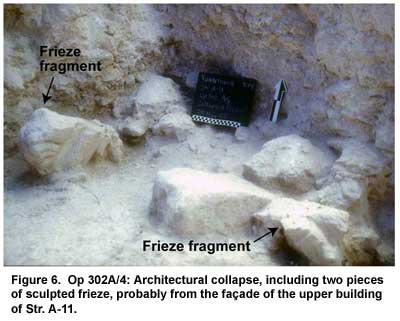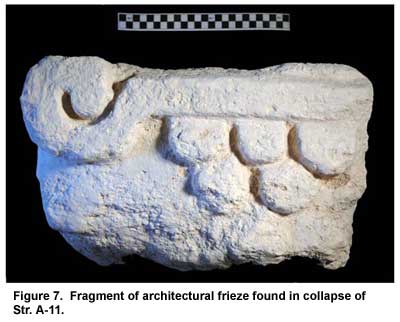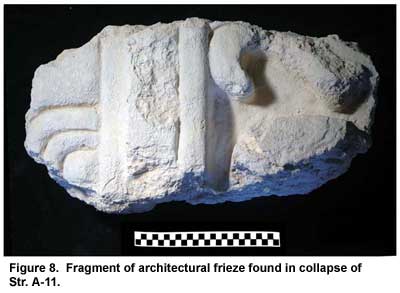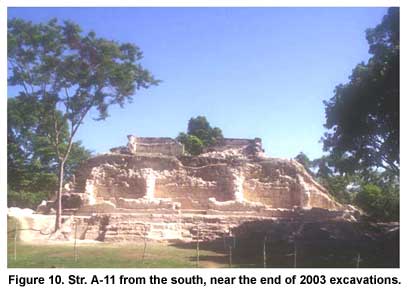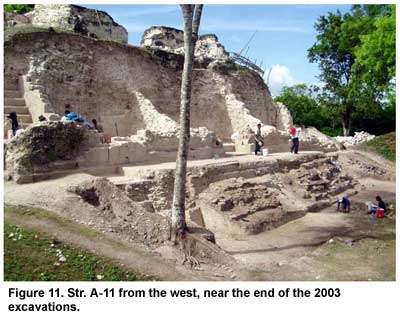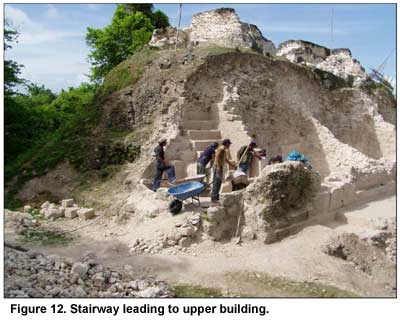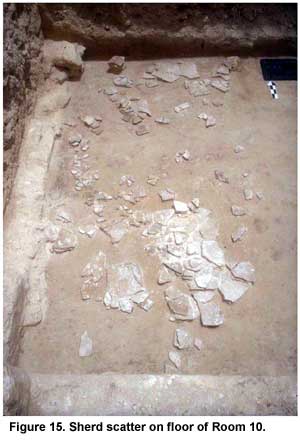
| FAMSI © 2005: Jason Yaeger |
||
Revisiting the Xunantunich Palace: The 2003 Excavations Findings The findings of the XPE are best presented as a chronological narrative of the construction, use, and abandonment of Str. A-11, from earliest to latest activities. Based on our 2003 excavations and previous work, we can identify five main phases of activity in Str. A-11, many of which we can confidently correlate with construction episodes and activities in other areas of the palace compound. I. Initial Construction of Plaza A-III and Associated Structures, including Str. A-11 Sometime early in the Hats’ Chaak phase, the Maya of Xunantunich began the construction of Plaza A-III, burying an older Middle Preclassic settlement (Yaeger 1997). This initial massive construction effort established a basic template for the palace’s layout. Although subsequent modifications–sealing alleyways, extending terraces and sub-structure platforms, modifying superstructures–changed some of the buildings, generally blocking off view and access to Plaza A-III from other parts of the site, they did not change significantly the basic plan of the plaza. The first step in the construction process was to level off the area under Plaza A-III by adding artificial fill consisting of marl and large pieces of limestone rubble. The result was a broad, raised surface upon which were raised early versions of Strs. A-10, A-11, A-12, A-13, the area between them being paved to form Plaza A-III. The Maya laid the most fill in the southwest corner of Plaza A-III, where bedrock was significantly lower than in other areas. In the northeast sector of Plaza A-III and under the adjacent Strs. A-11 and A-12, almost no fill was needed to level off the plaza surface. In this area of the compound, Late Classic building activity covered but did not apparently disturb a much older Middle Preclassic occupation, the remains of which were found well preserved under a dark matrix that is likely a buried A-Horizon that represents the ground surface at the time of the Late Classic construction (seen in Figure 5, below). This first construction of Str. A-11 coincides with the initial plaster floor of Plaza A-III, and thus the massive fill event just described. MacKie (1985:44), Harrison (1996:78), van der Krift, and I (Yaeger 1997) all identified two major flooring episodes in Plaza A-III, separated by some 20 cm of fill (Figure 5, above). The earlier floor surface runs under the basal course of substructure facing of Str. A-11, but a bead of plaster was worked into the junction. The lack of evidence for earlier substructures in 1997 probing excavations suggests that the plaster floor ended under the basal course. It seems likely that the earliest finished plaster surface extended just under the substructure facings, providing a hard, level surface for placing those cut stones. The early floor was later resurfaced, the new floor lipping up to both the substructure and the stairway. The stratigraphic link indicating contemporaneity of the construction of Str. A-11 and the earliest plaza floor allows us to tie the initial building of Str. A-11 to the first versions of Strs. A-12 and A-10, which were also built in conjunction with the first plaza floor. Clearly the Plaza A-III compound was conceived of as a single unit and built with a plan that changed little in its overall form over time, and Str. A-11 delimited the northern edge of the new compound. From its inception, this structure was conceived of as a two-story building, but the two stories were organized very differently, as can be appreciated on Figure 4 and Figure 9. As MacKie’s excavations demonstrated, the upper building had a T-shaped layout (MacKie 1985:figure 6). The heart of the upper building was Room 1, a large chamber measuring 11.6 × 2.6 m that faced south onto a broad frontal terrace. Low benches occupied both ends of the room, and an interior doorway led south into Room 2, a smaller room (4.3 × 2.3 m) with a raised floor surface. Yet another doorway pierced the northern wall of Room 2, leading either to another room or a recessed niche (Room 6), which had unfortunately largely fallen away down the north slope of the mound by the time of MacKie’s excavations. Regardless of where it led, the Maya later blocked this passage with a masonry wall. MacKie recovered four vases and bowls and over a dozen water storage jars broken in situ on the floor in Rooms 1 and 2. This assemblage is clearly associated with the storage of liquids and the consumption of food and beverages. Three patolli boards were incised on the floors of those same rooms. On either side of the central room lay two smaller flanking rooms, spanned with transverse vaults, each with a doorway that faced laterally. MacKie excavated the western room, Room 3, which measured 3.8 × 2.6 m. He found another pair of patolli boards on the floor of that room. We excavated the eastern room, Room 4, in 2003. The overall layout of the upper building and the restricted functions of the pottery vessels found in Rooms 1 and 2 have led both MacKie (1985) and Yaeger (1997) to argue that the upper building was the private residence of the Xunantunich ruler. MacKie (1985:33, Plate 36) recovered fragments of carved and plastered limestone blocks in architectural collapse from the north side of the upper building, near Room 3. We found several sculpted fragments in the upper levels of architectural collapse in the rooms of the lower building (Figure 6, shown above, and Figures 7 & 8, shown below). These levels include blocks and other architectural material that derived from the collapse of the south face of the upper building. Together, these findings indicate that a decorative frieze decorated at least the north and south sides of the upper building, likely running around the entire structure framed by the building’s medial and superior moldings. With its two-story façade and decorative frieze, Str. A-11 would have presented clear architectural parallels to Str. A-6-1st on the summit of the Castillo, a fact also noted by MacKie (1985:44). The lack of frieze fragments in collapse on the frontal terrace of the lower building suggests that it was not decorated in a similar manner. The lower building consisted of a gallery of five rooms accessed by three doorways that opened onto a broad frontal terrace (Figure 9, Figures 10 and 11, shown below). The central doorway led to the large central room, Room 9, the floor of which was raised above the surface of the frontal terrace. Flanking doorways to the east and west of the central doorway provided access to smaller rooms on either side of the central room, which were also characterized by raised interior floor surfaces. Within these flanking rooms, interior doorways led to even smaller rooms located at the building’s lateral extremes. In the western room, a very steep interior stairway with a corbel vaulted ceiling led up from the interior passageway to emerge in front of the doorway of Room 3 of the upper building (Figure 12, below). This narrow passage provided the only access to the upper building and the ruler’s residence at this time. All of the doorways of the lower building had holes with rods for tying curtains to limit visual and physical access into the rooms. The contents of the rooms of the lower building suggest that a very different set of activities occurred there, in contrast to the upper building. In Room 9, we found two incised patolli boards (Figure 13, below), fragments of a broken drum, and registers of incised "graffiti" decorations (Figure 14, below) that probably represent visions achieved during ritual trances (Haviland and Haviland 1995). In Rooms 7 and 8, to the west, one arm of a patolli board was carved on the floor of one room, while graffiti was incised on the walls of the room and on the walls defining the stairway that lead to the upper building. In Rooms 10 and 11 to the east, another patolli board was encountered on the floor. These walls might have borne graffiti like those found in rooms to the west, but, because the Maya dismantled this room, it is impossible to confirm this pattern.
In addition to these ritually charged images and artifacts, large pottery fragments representing a few whole vessels carpeted the floor of the central and eastern rooms (Figure 15, shown below), much in the same manner as the in situ vessels MacKie found in the upper building. Unlike the serving vessels found in the ruler’s residence in the upper building, as discussed above, the vessels in the lower building were large jars and neckless ollas, which LeCount (1996) suggests would have been used for long-term storage of either liquids or dry goods, possibly food or drink to be consumed. Their large size suggests that the vessels were stationary features in these rooms. All these findings point to the use of at least the central room as a place for private or semi-private religious experiences by the ruler and/or his close associates. Interestingly, except for one asterisk-like incision on a bench in Room 2, MacKie found no incised graffiti on the walls of the upper building, despite good plaster preservation, demonstrating that the ruler and ruling family did not record trance images in their living quarters. The lower building’s frontal terrace was elevated 1.85 m above the paved surface of Plaza A-III, and a broad central stairway made with large cut-stone blocks that had slightly battered risers provided access from the plaza. In its original form as seen on Figure 9, a wide masonry stair block in the middle of the stairway effectively extended the surface of the frontal terrace out over the stairway and brought it closer to the plaza. This block was later removed and replaced with stairs. The data collected by the Xunantunich Palace Excavations and previous research indicate that Plaza A-III complex was the residence and court of the Xunantunich rulers during the Hats’ Chaak phase. Its location and internal spatial divisions suggest it was an important venue for the ruling family and its representatives to interact with their subjects. Furthermore, the built environment divides this space into five distinct levels of increasingly restricted space. The entrance to Xunantunich from the Mopan valley was via the Northeast Complex (Figure 3), a paved causeway that led to Plaza A-II (Keller 1995). The entire northern side of Plaza A-II was dominated by the elevated platform of Str. A-13, which would have been visually prominent to arriving visitors. Furthermore, the stairway leading up to Str. A-13 would have been easily accessible, suggesting that at least some of the activities in Str. A-13 and the architectural spaces reached through Str. A-13 were meant for a relatively large segment of the visiting public. Excavations by Belize Department of Archaeology personnel in the 1980s revealed that the rooms along Str. A-13’s south side all contain benches that faced outward. The lack of reported in situ assemblages in these rooms makes their identification difficult, but their high benches, proximity to the city’s main entrance, and lack of privacy suggest a more public, administrative function. It is plausible that hinterland residents would have consulted with the representatives of the polity’s rulers here about matters like tribute payments, village disputes, and ritual concerns. It formed the first level of access to the court, the least restricted in terms of both physical and visual accessibility. The principal entrance to Plaza A-III, the heart of the palace complex, is a single large doorway located at the mid-point of Str. A-13 and flanked by small rooms (Figure 4). This entryway created a second level of access to the court, as the doorway led to Plaza A-III and the adjacent northern gallery of Str. A-13. These rooms, facing Plaza A-III, are identical in architectural form and internal features to those on the south side, suggesting that they were used for broadly similar activities, but only by those people permitted to enter Plaza A-III.
A third level of restricted access to the ruler’s court was created architecturally by the stairways leading up to the broad, raised frontal terraces of the substructure platforms of the other three structures flanking Plaza A-III, Strs. A-10, A-11, and A-12. Especially interesting is Str. A-11: the stairway up to the frontal terrace of Str. A-11 had a large stair block that created a stage-like extension of the frontal terrace out toward the plaza. This feature suggests that some of the activities on the frontal terrace interaction were for public consumption. Associated with the frontal terrace, we also found fragments of a carved wall panel with an inscription that bears the child-of-father glyph but is otherwise incomplete (Figure 16, above). The rooms of the superstructures of Strs. A-10, A-12, and Str. A-11’s lower building constitute yet a fourth level of access. Directly under the ruler’s residential suite and connected to it, the five rooms of the lower building of Str. A-11 provided spaces for more restricted, private interaction and consultation with members of the court, including perhaps the ruler. These practices may have included consultation of the spiritual realm by the ruler or other members of the royal court, given the presence of incised patolli boards, a broken drum in the central room, and registers of graffiti that probably represent visions achieved during ritual trances (Figure 13 and Figure 14; Haviland and Haviland 1995). Curtain holders on the three external doorways of the lower building made it possible to hide the interactions and other activities in those rooms from any people on the frontal terrace or in Plaza A-III. The final and most restricted zone consisted of the ruler’s residential compound itself, the upper building of Str. A-11. As noted above, the only access to this area was by an interior stairway hidden within the lower building. |
||
|
Text links to all pages at this site are available at the FAMSI INDEX |
||
